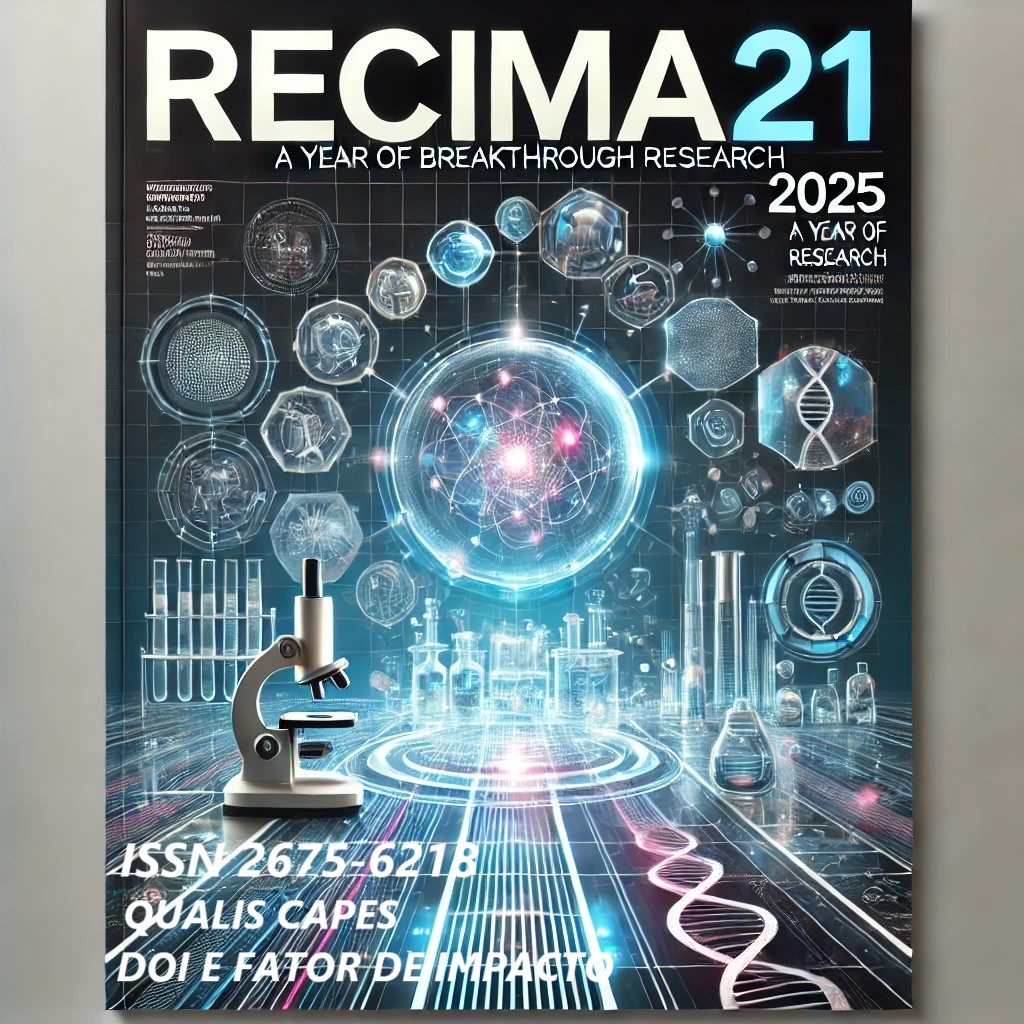APLICACIONES DE LA ESPECTROSCOPÍA FUNCIONAL DEL INFRARROJO CERCANO (FNIRS) PARA LA EVALUACIÓN DE TINNIS: UNA REVISIÓN DEL ALCANCE
DOI:
https://doi.org/10.47820/recima21.v6i5.6398Palabras clave:
Tinnitus, espectroscopia de infrarrojo cercano, mapeo cerebral, neuroimagen funcional, revisión de la literatura, audiologíaResumen
OBJETIVO: identificar las aplicaciones de fNIRS en la evaluación del tinnitus y verificar variaciones en los niveles de oxihemoglobina y desoxihemoglobina entre estudios empíricos que involucran individuos con tinnitus. MÉTODOS: La presente revisión de alcance implicó una búsqueda sistemática de revistas revisadas por pares, centrándose en estudios empíricos, participantes humanos con tinnitus evaluados mediante fNIRS. Se combinaron los términos espectroscopia de infrarrojo cercano y tinnitus. Se buscaron en bases de datos, PubMed, Medline, Web of Science, Scopus, Cochrane Library, LILACS, Biblioteca Virtual em Saúde y EMBASE, cubriendo artículos publicados hasta el 21 de julio de 2023. Dos investigadores independientes realizaron la selección inicial, con discrepancias resueltas por un tercero. RESULTADOS: Se incluyeron diez estudios. Cuatro compararon los cambios de oxihemoglobina en participantes con tinnitus y controles. Uno adaptó una sonda en el canal auditivo externo para su uso en equipos fNIRS, mientras que otro evaluó su eficacia funcional. fNIRS evaluó la mejora de la función de la corteza auditiva mediante estimulación transcraneal de corriente directa en el tinnitus crónico. Los estudios longitudinales han utilizado fNIRS para evaluar la eficacia de la estimulación magnética transcraneal, la terapia con muescas y la acupuntura en el tratamiento del tinnitus. Cinco diseños experimentales abarcaron diseños de evaluación en bloques, tres desarrollaron experimentos en estado de reposo y dos estudios utilizaron ambos. Estos exploraron cambios en la actividad cerebral utilizando estímulos de tonos puros y ruidos enmascarantes.
Descargas
Referencias
1. Ferrari M, Quaresima V. A brief review on the history of human functional near-infrared spectroscopy (fNIRS) development and fields of application. Neuroimage. 2012;63(2):921-35. DOI: https://doi.org/10.1016/j.neuroimage.2012.03.049
2. Basura GJ, Hu XS, Juan JS, Tessier AM, Kovelman I. Human central auditory plasticity: A review of functional near-infrared spectroscopy (fNIRS) to measure cochlear implant performance and tinnitus perception. Laryngoscope Investig Otolaryngol. 2018;3(6):463-72. DOI: https://doi.org/10.1002/lio2.185
3. Mehagnoul-Schipper DJ, van der Kallen BF, Colier WN, van der Sluijs MC, van Erning LJ, Thijssen HO, et al. Simultaneous measurements of cerebral oxygenation changes during brain activation by near-infrared spectroscopy and functional magnetic resonance imaging in healthy young and elderly subjects. Hum Brain Mapp. 2002;16(1):14-23. DOI: https://doi.org/10.1002/hbm.10026
4. Huppert TJ, Hoge RD, Diamond SG, Franceschini MA, Boas DA. A temporal comparison of BOLD, ASL, and NIRS hemodynamic responses to motor stimuli in adult humans. Neuroimage. 2006;29(2):368-82. DOI: https://doi.org/10.1016/j.neuroimage.2005.08.065
5. Zhai T, Ash-Rafzadeh A, Hu X, Kim J, San Juan JD, Filipiak C, et al. Tinnitus and auditory cortex; Using adapted functional near-infrared-spectroscopy to expand brain imaging in humans. Laryngoscope Investigative Otolaryngology. 2021;6(1):137-44.
6. Zhou X, Feng M, Hu Y, Zhang C, Zhang Q, Luo X, et al. The Effects of Cortical Reorganization and Applications of Functional Near-Infrared Spectroscopy in Deaf People and Cochlear Implant Users. Brain Sci. 2022;12(9). DOI: https://doi.org/10.3390/brainsci12091150
7. Noreña AJ, Farley BJ. Tinnitus-related neural activity: theories of generation, propagation, and centralization. Hear Res. 2013;295:161-71. DOI: https://doi.org/10.1016/j.heares.2012.09.010
8. Noreña AJ, Eggermont JJ. Changes in spontaneous neural activity immediately after an acoustic trauma: implications for neural correlates of tinnitus. Hear Res. 2003;183(1-2):137-53. DOI: https://doi.org/10.1016/S0378-5955(03)00225-9
9. Noreña AJ, Eggermont JJ. Enriched acoustic environment after noise trauma reduces hearing loss and prevents cortical map reorganization. J Neurosci. 2005;25(3):699-705. DOI: https://doi.org/10.1523/JNEUROSCI.2226-04.2005
10. Vanneste S, Plazier M, der Loo E, de Heyning PV, Congedo M, De Ridder D. The neural correlates of tinnitus-related distress. Neuroimage. 2010;52(2):470-80. DOI: https://doi.org/10.1016/j.neuroimage.2010.04.029
11. Park Y, Shin SH, Byun SW, Lee ZY, Lee HY. Audiological and psychological assessment of tinnitus patients with normal hearing. Front Neurol. 2022;13:1102294. DOI: https://doi.org/10.3389/fneur.2022.1102294
12. NICE. Tinnitus: assessment and management. National Institute for Health and Care Excellence: Guidelines [Internet]. 2020.
13. Dobel C, Junghöfer M, Mazurek B, Paraskevopoulos E, Groß J. Tinnitus and Multimodal Cortical Interaction. Laryngorhinootologie. 2023;102(S 01):S59-s66. DOI: https://doi.org/10.1055/a-1959-3021
14. Moher D, Liberati A, Tetzlaff J, Altman DG. Preferred reporting items for systematic reviews and meta-analyses: the PRISMA statement. BMJ. 2009;339:b2535. DOI: https://doi.org/10.1136/bmj.b2535
15. Tricco AC, Lillie E, Zarin W, O'Brien KK, Colquhoun H, Levac D, et al. PRISMA Extension for Scoping Reviews (PRISMA-ScR): Checklist and Explanation. Annals of Internal Medicine. 2018;169(7):467-73. DOI: https://doi.org/10.7326/M18-0850
16. Cohen J. A coefficient of agreement for nominal scales. Educational and Psychological Measurement. 1960;20:37-46. DOI: https://doi.org/10.1177/001316446002000104
17. Matthew J Page, Joanne E McKenzie, Patrick M Bossuyt, Isabelle Boutron, Tammy C Hoffmann, Cynthia D Mulrow, et al. The PRISMA 2020 statement: an updated guideline for reporting systematic reviews. BMJ. 2021;372(71).
18. Schecklmann M, Giani A, Tupak S, Langguth B, Raab V, Polak T, et al. Functional near-infrared spectroscopy to probe state- and trait-like conditions in chronic tinnitus: a proof-of-principle study. Neural Plast. 2014;2014:894203. DOI: https://doi.org/10.1155/2014/894203
19. Issa M, Bisconti S, Kovelman I, Kileny P, Basura GJ. Human auditory and adjacent nonauditory cerebral cortices are hypermetabolic in tinnitus as measured by functional near-infrared spectroscopy (fNIRS). Neural Plasticity. 2016;2016. DOI: https://doi.org/10.1155/2016/7453149
20. San Juan J, Hu XS, Issa M, Bisconti S, Kovelman I, Kileny P, et al. Tinnitus alters resting state functional connectivity (RSFC) in human auditory and non-auditory brain regions as measured by functional near-infrared spectroscopy (fNIRS). PLoS One. 2017;12(6):e0179150.
21. Verma R, Jha A, Singh S. Functional Near-Infrared Spectroscopy to Probe tDCS-Induced Cortical Functioning Changes in Tinnitus. J Int Adv Otol. 2019;15(2):321-5. DOI: https://doi.org/10.5152/iao.2019.6022
22. Shoushtarian M, Alizadehsani R, Khosravi A, Acevedo N, McKay CM, Nahavandi S, et al. Objective measurement of tinnitus using functional near-infrared spectroscopy and machine learning. PLoS One. 2020;15(11):e0241695. DOI: https://doi.org/10.1371/journal.pone.0241695
23. Sun Q, Wang X, Huang B, Sun J, Li J, Zhuang H, et al. Cortical Activation Patterns of Different Masking Noises and Correlation With Their Masking Efficacy, Determined by Functional Near-Infrared Spectroscopy. Frontiers in Human Neuroscience. 2020;14. DOI: https://doi.org/10.3389/fnhum.2020.00149
24. Zhai T, Ash-Rafzadeh A, Hu X, Kim J, San Juan JD, Filipiak C, et al. Tinnitus and auditory cortex; Using adapted functional near-infrared-spectroscopy to expand brain imaging in humans. Laryngoscope Investig Otolaryngol. 2021;6(1):137-44. DOI: https://doi.org/10.1002/lio2.510
25. San Juan JD, Zhai T, Ash-Rafzadeh A, Hu XS, Kim J, Filipak C, et al. Tinnitus and auditory cortex: using adapted functional near-infrared spectroscopy to measure resting-state functional connectivity. Neuroreport. 2021;32(1):66-75. DOI: https://doi.org/10.1097/WNR.0000000000001561
26. Huang B, Wang X, Wei F, Sun Q, Sun J, Liang Y, et al. Notched Sound Alleviates Tinnitus by Reorganization Emotional Center. Frontiers in Human Neuroscience. 2022;15. DOI: https://doi.org/10.3389/fnhum.2021.762492
27. Yu X, Gong B, Yang H, Wang Z, Qi G, Sun J, et al. Effect of acupuncture treatment on cortical activation in patients with tinnitus: A functional near-infrared spectroscopy study. IEEE Trans Neural Syst Rehabil Eng. 2023;Pp. DOI: https://doi.org/10.1109/TNSRE.2022.3231899
28. Juan JS, Hu XS, Issa M, Bisconti S, Kovelman I, Kileny P, et al. Tinnitus alters resting state functional connectivity (RSFC) in human auditory and non-auditory brain regions as measured by functional near-infrared spectroscopy (fNIRS). PLoS ONE. 2017;12(6). DOI: https://doi.org/10.1371/journal.pone.0179150
29. Kandeepan S, Maudoux A, Ribeiro de Paula D, Zheng JY, Cabay JE, Gómez F, et al. Tinnitus distress: a paradoxical attention to the sound? J Neurol. 2019;266(9):2197-207. DOI: https://doi.org/10.1007/s00415-019-09390-1
30. Vanneste S, De Ridder D. Stress-Related Functional Connectivity Changes Between Auditory Cortex and Cingulate in Tinnitus. Brain Connect. 2015;5(6):371-83. DOI: https://doi.org/10.1089/brain.2014.0255
31. Zimmerman BJ, Abraham I, Schmidt SA, Baryshnikov Y, Husain FT. Dissociating tinnitus patients from healthy controls using resting-state cyclicity analysis and clustering. Netw Neurosci. 2019;3(1):67-89. DOI: https://doi.org/10.1162/netn_a_00053
32. Mohan A, Moreno N, Song JJ, De Ridder D, Vanneste S. Evidence for Behaviorally Segregated, Spatiotemporally Overlapping Subnetworks in Phantom Sound Perception. Brain Connect. 2017;7(3):197-210. DOI: https://doi.org/10.1089/brain.2016.0459
33. Cui X, Bray S, Bryant DM, Glover GH, Reiss AL. A quantitative comparison of NIRS and fMRI across multiple cognitive tasks. NeuroImage. 2011;54(4):2808-21. DOI: https://doi.org/10.1016/j.neuroimage.2010.10.069
34. Li R, Yang D, Fang F, Hong K-S, Reiss AL, Zhang Y. Concurrent fNIRS and EEG for Brain Function Investigation: A Systematic, Methodology-Focused Review. Sensors [Internet]. 2022;22(15). DOI: https://doi.org/10.3390/s22155865
35. Bourez PH, Fournier P, Noreña AJ. The difference in poststimulus suppression between residual inhibition and forward masking. Prog Brain Res. 2021;262:23-56. DOI: https://doi.org/10.1016/bs.pbr.2020.08.010
36. Perez-Carpena P, Bibas A, Lopez-Escamez JA, Vardonikolaki K, Kikidis D. Systematic review of sound stimulation to elicit tinnitus residual inhibition. Prog Brain Res. 2021;262:1-21. DOI: https://doi.org/10.1016/bs.pbr.2021.01.020
37. Schoisswohl S, Schecklmann M, Langguth B, Schlee W, Neff P. Neurophysiological correlates of residual inhibition in tinnitus: Hints for trait-like EEG power spectra. Clin Neurophysiol. 2021;132(7):1694-707. DOI: https://doi.org/10.1016/j.clinph.2021.03.038
Descargas
Publicado
Licencia
Derechos de autor 2025 RECIMA21 - Revista Científica Multidisciplinar - ISSN 2675-6218

Esta obra está bajo una licencia internacional Creative Commons Atribución 4.0.
Os direitos autorais dos artigos/resenhas/TCCs publicados pertecem à revista RECIMA21, e seguem o padrão Creative Commons (CC BY 4.0), permitindo a cópia ou reprodução, desde que cite a fonte e respeite os direitos dos autores e contenham menção aos mesmos nos créditos. Toda e qualquer obra publicada na revista, seu conteúdo é de responsabilidade dos autores, cabendo a RECIMA21 apenas ser o veículo de divulgação, seguindo os padrões nacionais e internacionais de publicação.













